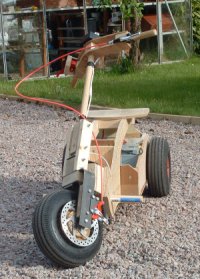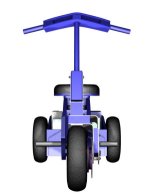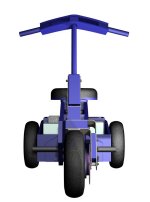 The
Trike is the simplest buggy design I could think of whilst still keeping the performance
reasonable and keeping it “buildable” by competent DIY ers and home-builders using non-specialised
tools and materials. It has a mainly timber “glued and screwed” construction, a rear double
reduction drive gearbox, 10” pneumatic wheels and a front disc brake. Several key strength components are made of
steel and throughout use is made of standard
stock engineering components such as
bearings, bright steel bar,
gears,
sprockets
etc. The trike's laden center
of gravity is a bit forward of the rear wheels which
gives a balance between weight over the rear wheels for
traction and download at the front for steering and
braking. Its main structure is rigidly fixed to the
drive unit so does not need to be “balanced” like the
tilting trike or scooter – it's easier to ride.
The
Trike is the simplest buggy design I could think of whilst still keeping the performance
reasonable and keeping it “buildable” by competent DIY ers and home-builders using non-specialised
tools and materials. It has a mainly timber “glued and screwed” construction, a rear double
reduction drive gearbox, 10” pneumatic wheels and a front disc brake. Several key strength components are made of
steel and throughout use is made of standard
stock engineering components such as
bearings, bright steel bar,
gears,
sprockets
etc. The trike's laden center
of gravity is a bit forward of the rear wheels which
gives a balance between weight over the rear wheels for
traction and download at the front for steering and
braking. Its main structure is rigidly fixed to the
drive unit so does not need to be “balanced” like the
tilting trike or scooter – it's easier to ride.
 The pictures show the single
motor design but a double motor version could also be
built both of which use 250W electric scooter
motors which are commonly available in both the UK and US. Obviously the single motor trike is the simpler of the two
and has fewer parts but the simplicity and lower cost has the obvious consequence of lower power output (250W). There is also a traction related drawback - to keep the high levels of manoeuvrability offered by the single front steering wheel we found it was best with the single motor drive to drive only one of the rear wheels
and leave the other free-wheeling; the alternative was to drive both rear wheels through a fixed rear axle – an arrangement we experimented with but found, because there is no differential action, that the steering effectiveness was badly compromised. We found that the traction from one driven wheel is easily sufficient to drive the trike on reasonably good drives surfaces – see the movie clips below.
The pictures show the single
motor design but a double motor version could also be
built both of which use 250W electric scooter
motors which are commonly available in both the UK and US. Obviously the single motor trike is the simpler of the two
and has fewer parts but the simplicity and lower cost has the obvious consequence of lower power output (250W). There is also a traction related drawback - to keep the high levels of manoeuvrability offered by the single front steering wheel we found it was best with the single motor drive to drive only one of the rear wheels
and leave the other free-wheeling; the alternative was to drive both rear wheels through a fixed rear axle – an arrangement we experimented with but found, because there is no differential action, that the steering effectiveness was badly compromised. We found that the traction from one driven wheel is easily sufficient to drive the trike on reasonably good drives surfaces – see the movie clips below.
These steering problems are resolved with the double motor driven option - each of
the
 rear
rear
 wheels is
driven by its own
motor, each develops
traction
and the speed/torque characteristics of the motors ensures effective differential action when they are wired in parallel to the same
controller. A further key advantage of the double motor drive is the higher power output (500W). In some vehicles this could be exploited though a higher speed transmission to the wheels but with this
vehicle it's probably better to use the power to increase the available wheel drive torque and allow the trike to be used on poorer surfaces found in many gardens – hard gravel paths, mown grass lawns etc. Trike2 is slightly wider over the rear wheels than Trike1.
wheels is
driven by its own
motor, each develops
traction
and the speed/torque characteristics of the motors ensures effective differential action when they are wired in parallel to the same
controller. A further key advantage of the double motor drive is the higher power output (500W). In some vehicles this could be exploited though a higher speed transmission to the wheels but with this
vehicle it's probably better to use the power to increase the available wheel drive torque and allow the trike to be used on poorer surfaces found in many gardens – hard gravel paths, mown grass lawns etc. Trike2 is slightly wider over the rear wheels than Trike1.
These characteristics and the 10” wheels and relatively low ground clearance (about 3.5”) mean the trike isn't really an off-roader and is best suited for good (hard and flat) drive surfaces. The double motor drive though extends the capability to hard gravel and cut grass lawns and modest hill climbing.
 The
gearbox is a key part of the design and is described in more detail
here. The boxes are home-built too and are efficient, reversible, back-driveable and allow the builder choice in the overall reduction ratio and hence output speed – watch this though, using too high an output speed simply results in over torqued, over heated motors which won't last. We have found that gearing to produce a top speed of about 7 to 8 mph is probably the maximum for use on good drive surfaces and less than this for poorer higher drag surfaces. Clearly the higher power version does better with the heavier riders and poorer surfaces. An interesting exercise is to check the specs for 250W and 500W electric scooters you can buy – see how they compare.
The
gearbox is a key part of the design and is described in more detail
here. The boxes are home-built too and are efficient, reversible, back-driveable and allow the builder choice in the overall reduction ratio and hence output speed – watch this though, using too high an output speed simply results in over torqued, over heated motors which won't last. We have found that gearing to produce a top speed of about 7 to 8 mph is probably the maximum for use on good drive surfaces and less than this for poorer higher drag surfaces. Clearly the higher power version does better with the heavier riders and poorer surfaces. An interesting exercise is to check the specs for 250W and 500W electric scooters you can buy – see how they compare.
The electrical system is standard for small electric vehicles ie motor(s), motor controller,
batteries and speed/reverse/ignition
controls. The choice of controller is largely the builder's but t
he controller used on our single motor trike is the 24V 40 Amp
Vortex
controller from 4QD which has worked well – the 75Amp
version is needed for the double motor drive. Room for
two 12 V 38AmpH deep cycle batteries wired in series is
built-in to the structure and these give a
continuous
running time between charges of about 2 hours for the single motor drive. For similar driving conditions the range for the double motor version will be a bit less – though not half, the power consumed depends mainly on vehicle duty and weight not number of motors. Running time reduces with use on harder driving surfaces.
All in all - quite a cool little run-about.